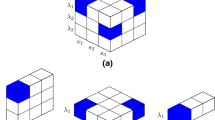Abstract
We investigate further the existence question regarding optimal (v, 4, 2, 1) optical orthogonal codes begun in Momihara and Buratti (IEEE Trans Inform Theory 55:514–523, 2009). We give some non-existence results for infinitely many values of v ≡ ± 3 (mod 9) and several explicit constructions for infinite classes of perfect optical orthogonal codes.
Similar content being viewed by others
References
Abel R.J.R., Buratti M.: Some progress on (v, 4, 1) difference families and optical orthogonal codes. J. Combin. Theory Ser. A 106, 59–75 (2004).
Abel, R.J.R., Buratti, M.: Difference families. In: Colbourn, C.J., Dinitz, J.H. (eds.) The CRC Handbook of Combinatorial Designs, 2nd edn., pp. 392–409. Chapman & Hall/CRC Press, Boca Raton, FL (2006).
Alderson T.L., Mellinger K.E.: Families of optimal OOCs with λ = 2. IEEE Trans. Inform. Theory 54, 3722–3724 (2008).
Alderson T.L., Mellinger K.E.: Geometric constructions of optimal optical orthogonal codes. Adv. Math. Commun. 2, 451–467 (2008).
Beth T., Jungnickel D., Lenz H.: Design Theory. Cambridge University Press, Cambridge (1999).
Bird I.C.M., Keedwell A.D.: Design and applications of optical orthogonal codes—a survey. Bull. Inst. Combin. Appl. 11, 21–44 (1994).
Bonisoli A., Buratti M., Rinaldi G.: Sharply transitive decompositions of complete graphs into generalized Petersen graphs. Innov. Incidence Geom. 6(7), 95–109 (2009).
Bose R.C.: On the construction of balanced incomplete block designs. Ann. Eugenics 9, 353–399 (1939).
Brickell E.F., Wei V.: Optical orthogonal codes and cyclic block designs. Congr. Numer. 58, 175–182 (1987).
Buratti M.: Recursive constructions for difference matrices and relative difference families. J. Combin. Des. 6, 165–182 (1998).
Buratti M.: Cyclic designs with block size 4 and related optimal optical orthogonal codes. Des. Codes Cryptogr. 26, 111–125 (2002).
Buratti M., Pasotti A.: Combinatorial designs and the theorem of Weil on multiplicative character sums. Finite Fields Appl. 15, 332–344 (2009).
Buratti M., Pasotti A.: Further progress on difference families with block size 4 or 5. Des. Codes Cryptogr. Published online (2009). doi:10.1007/s10623-009-9335-6.
Chang Y.X., Ji L.: Optimal (4up,5,1) optical orthogonal codes. J. Combin. Des. 12, 135–151 (2004).
Chen K., Zhu L.: Existence of (q,6,1) difference families with q a prime power. Des. Codes Cryptogr. 15, 167–173 (1998).
Chen K., Zhu L.: Existence of (q,k,1) difference families with q a prime power and k = 4, 5. J. Combin. Des. 7, 21–30 (1999).
Chu W., Colbourn C.J.: Recursive constructions for optimal (n, 4, 2)-OOCs. J. Combin. Des. 12, 333–345 (2004).
Chung F.R.K., Salehi J.A., Wei V.K.: Optical orthogonal codes: design, analysis and applications. IEEE Trans. Inform. Theory 35, 595–604 (1989).
Colbourn C.J., Dinitz J.H., Stinson D.R.: Applications of combinatorial designs to communications, cryptography, and networking. In: Lamb J.D., Preece D.A. (eds.) Surveys in Combinatorics, pp. 37–100. Cambridge University Press, London (1999).
Feng T., Chang Y., Ji L.: Constructions for strictly cyclic 3-designs and applications to optimal OOCs with λ = 2. J. Combin. Theory Ser. A 115, 1527–1551 (2008).
Ma S., Chang Y.: Constructions of optimal optical orthogonal codes with weight five. J. Combin. Des. 13, 54–69 (2005).
Mishima M., Fu H.L., Uruno S.: Optimal conflict-avoiding codes of length n ≡ 0 (mod 16) and weight 3. Des. Codes Cryptogr. 52, 275–291 (2009).
Momihara K.: On cyclic 2(k −1)-support (n, k)k−1 difference families. Finite Fields Appl. 15, 415–427 (2009).
Momihara K.: Strong difference families, difference covers, and their applications for relative difference families. Des. Codes Cryptogr. 51, 253–273 (2009).
Momihara K., Buratti M.: Bounds and constructions of optimal (n, 4, 2, 1) Optical orthogonal codes. IEEE Trans. Inform. Theory 55, 514–523 (2009).
Wilson R.M.: Cyclotomic and difference families in elementary abelian groups. J. Number Theory 4, 17–47 (1972).
Yang G.C., Fuja T.E.: Optical orthogonal codes with unequal auto- and cross-correlation constraints. IEEE Trans. Inform. Theory 41, 96–106 (1995).
Author information
Authors and Affiliations
Corresponding author
Additional information
Communicated by Victor A. Zinoviev.
Rights and permissions
About this article
Cite this article
Buratti, M., Momihara, K. & Pasotti, A. New results on optimal (v, 4, 2, 1) optical orthogonal codes. Des. Codes Cryptogr. 58, 89–109 (2011). https://doi.org/10.1007/s10623-010-9382-z
Received:
Revised:
Accepted:
Published:
Issue Date:
DOI: https://doi.org/10.1007/s10623-010-9382-z



